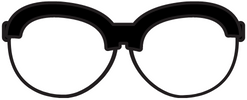Guides & How To, Pocket 101, Pocket DIY
Frame Measurement Guide
Choosing the right eyeglasses frame is essential for achieving optimal vision and comfort. With so many frame options available, it’s essential to know how to measure your eyeglasses frame correctly. Here is a comprehensive guide to measuring your eyeglasses frame, including the lens width, lens height, bridge width, frame width, and temple length. For ease of reference, you can record the measurements in millimeters.
1. Measure Your Lens Width

The lens width is the horizontal distance across the lenses’ widest point, and it is typically measured in millimeters. Here’s how to measure your lens width:
- Take off your current eyeglasses and hold them up to a ruler or measuring tape.
- Measure and note the distance between the left edge of the left lens and the right edge of the right lens.
It’s important to choose a lens width that complements your face shape. Round faces should opt for wider lenses, while square faces should choose narrower lenses.
2. Measure Your Lens Height

The lens height is the vertical distance of the lens from top to bottom, and it is typically measured in millimeters. Here’s how to measure your lens height:
- Take off your current eyeglasses and hold them up to a ruler or measuring tape.
- Measure the distance between the top edge of the lens and the bottom edge of the lens.
- Record the measurement in millimeters.
When selecting new glasses, it’s essential to choose a lens height that is suitable for your vision needs. If you require bifocals or progressives, you’ll need a lens height that’s large enough to accommodate both distance and reading prescriptions.
The lens height is also often printed on the inside of the temple arm, along with other important measurements.
3. Measure Your Bridge Width

The bridge width is the distance between the two lenses, and it is typically measured in millimeters. Here’s how to measure your bridge width:
- Take off your current eyeglasses and hold them up to a ruler or measuring tape.
- Measure the distance between the two lenses’ closest points.
The bridge should sit comfortably on your nose. A bridge that is too narrow may pinch your nose, while a bridge that is too wide may slide down.
4. Measure Your Frame Width

The frame width is the distance across the entire front of the frame, from one end to the other, and it is typically measured in millimeters. Here’s how to measure your frame width:
- Take off your current eyeglasses and lay them flat on a table or other flat surface.
- Use a ruler or measuring tape to measure the distance across the entire front of the frame, from one end to the other.
When selecting new glasses, it’s important to choose a frame width that complements your face shape and matches your personal style.
5. Measure Your Temple Length

The temple length is the distance from the hinge to the end of the temple, which is the part that goes behind your ear. Here’s how to measure your temple length:
- Take off your current eyeglasses and hold them up to a ruler or measuring tape.
- Measure the distance from the hinge to the end of the temple.
- Record the measurement in millimeters.
You should choose a temple length that is long enough to fit comfortably behind your ears. A temple length that is too short may not stay in place, while a temple length that is too long may feel uncomfortable.
In conclusion, measuring your eyeglasses frame is an essential step in selecting the right glasses for your vision needs. By following these steps and considering your personal preferences, you can select the perfect frame that provides optimal vision and comfort. Remember to consult with your optometrist or optician for any questions or concerns about your eyewear.






















Where Vision Values Your Wallet